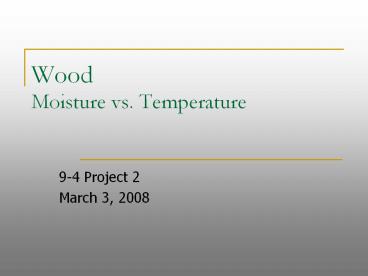Wood Moisture vs. Temperature PowerPoint PPT Presentation
1 / 15
Title: Wood Moisture vs. Temperature
1
Wood Moisture vs. Temperature
- 9-4 Project 2
- March 3, 2008
2
Purpose
- To find out how the size and dryness of wood
effects the efficiency of the process of fire.
3
Hypothesis
- Wood that is dried longer and split will burn
hotter in a shorter period of time than wood that
is less dry.
4
Materials
- 40 sheets of newspaper
- 10 fir junks, 4 diameter, 16 long, dried 1
year - 4 - 2 Lt milk cartons (empty)
- 40 dried fir splits for kindling
- Axe
- Chainsaw
- Measuring tape
- Paper
- Screw driver
- 16 fir junks, 4 diameter, 20 long, considered
green
- Thermal imagining camera
- 10 fir junks, 4 diameter, 16 long, dried 3
years - Outdoor wood matches
- Pencil
- Timer
- Wood horse
- Chopping block
- Chain lubricating oil
- Bucket
- Water
- Fuel gas/oil
5
Method
- Gather materials.
- Prepare chainsaw by filling with the correct
mixture of gasoline and oil, if required. Check
the level of chain lubricating oil and fill up,
if required. - Have an adult use a chain saw, to cut down a fir
tree with a 4 diameter and trim off branches.
Place log on wood horse. Use measuring tape to
measure lengths of 20 and mark by scratching
bark of tree with screwdriver. Cut log with
chainsaw where indicated. Continue cutting the
log until you have 16 pieces of wood. An
additional fir tree may be required in order to
get the required number of junks. Form a base for
each fire by arranging 4 junks of wood lying next
to each other, as close a possible. Allow 4
between each fire. Tear open milk carton and
spread flat on junks.
6
Method(continued)
- Gather 10 fir junks with 4 diameter, which has
been dried 1 year. Divide in two groups of 5
junks. Have an adult use an axe and split one
group of junks into splits. Keep separate from
other 5 junks. - Gather 10 fir junks with 4 diameter, which has
been dried 3 years. Divide in two groups of 5
junks. Have an adult use an axe and split one
group of junks into splits. Keep separate from
other 5 junks. - You should have 4 groups
- Split 1 year old wood
- Solid 1 year old wood in junks
- Split 3 years old wood
- Solid 3 years old wood in junks
7
Method(continued)
- Divide your newspaper into 4 groups having 10
sheet in each group. Crumple each sheet of
newspaper and place on log base - Take your 10 pieces of kindling and lay on top of
crumpled paper in a criss-cross pattern. - Use a match to light various pieces of paper
allow this fire to burn until it reaches at least
720f. Use thermal imaging camera to measure the
temperature. Lay the wood on top of fire and
start timer. Allow to burn for 20 minutes. Use
thermal imaging camera to measure temperature.
Record information on chart. - Repeat steps 8 and 9 for the next 3 fires.
- Analyze findings.
8
Variables
- Manipulated Age and diameter of wood used.
- Responding The temperature of the fire after
burning for 20 minutes. - Controlled
- The amount of paper.
- The amount of splits for kindling.
- The amount of wood.
- The time that the fire was allowed to burn.
9
Results
1 yr dried solid 3 yr dried solid 1 yr dried split 3 yr dried split
Fire temperature after burning for 20 minutes 496f 938f 598f 942f
10
Results (Continued)
- The 3 year old dried wood that was split burned
hotter than the wood that was 1 year old and
split. - The 3 year old dried wood that was a solid junk
burned hotter than 1 year old dried wood that was
a solid junk. - There isnt a significant different between wood
that was split compared to wood that was left in
a solid junk.
11
Results(comparing temperature in Fahrenheit)
12
Photos
13
Conclusion
- Wood that is dried longer burns hotter than wood
that isnt dried. Whether or not the wood was
solid or split didnt have a great effect on the
difference in temperature. Therefore, this
confirms that my hypothesis was so what correct.
14
Sources of Error
- The location, in the fire, that was measured for
temperature using the thermal imaging camera. - Direction of wind and the strength of wind
outdoors. - Placement of wood on the fire.
- The size and number of splits that the 5 junks
produced. - Whether or not the wood stacked on the fire had
to be repositioned during the burning. - Wood for the 5 junks for each of the groups
didnt come from the same tree.
15
Ways to Improve
- To have the wood from the same tree that was
dried 1 year and 3 years. - To have a larger base to place the fire.
- To measure the temperature that the fire burned
at more time intervals. - To light the 4 fires at the same time.

